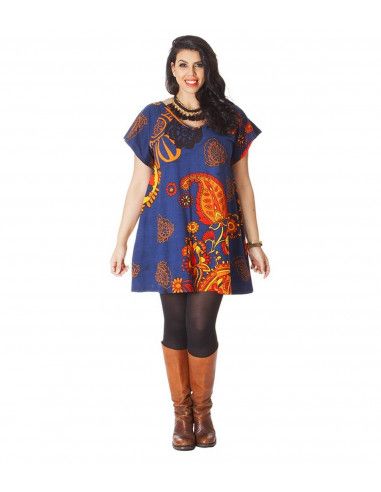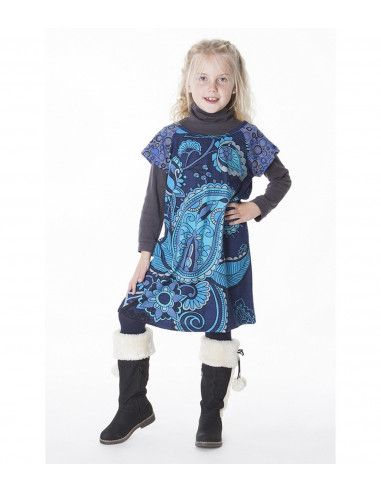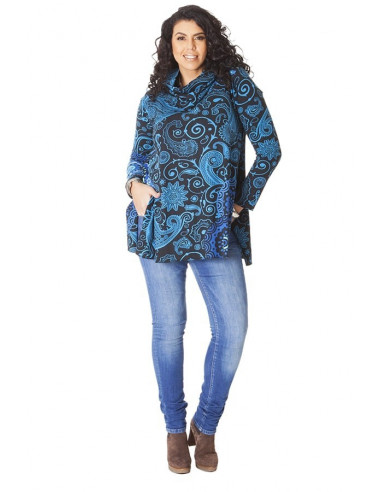- Tienda Hippie
- Prints and Patterns
- 0 likes
- 62785 views
Knowing what we wear and getting to the roots of Paisley design
The roots of the Paisley pattern, instantly recognizable by its drop shape or curved teardrop (almond), may surprise many people, who do not realize that their heritage goes back not only many hundreds of years, but also many thousands of miles. It is an interesting and varied story that shows that multiculturalism is by no means a new phenomenon. It may have experienced its ups and downs in popularity, but it has always been assured a place in the heart of the local population of Paisley, as well as reaching out to new audiences of fashionistas and design aficionados who strive to present their own vision of this traditional and beautiful pattern.
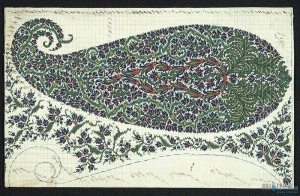
Origins of the Paisley:
The ancient Babylon where Iraq is now located is said to be the birthplace of the form of Kashmir, possibly dating back to 1700 B.C. Another view, expressed by Sam Willis in the 2016 BBC television series The Silk Road, is that the symbol originated in the city of Yazd in Iran. In Yazd originates the weaving of the traditional fabric called Termeh, a fabric made of silk and wool that often included the form of Kashmir. Another common theory is that it originated in Persia A.D. 200-650 during the rule of the Sasanids who created an empire whose armies held the Romans at bay for centuries.
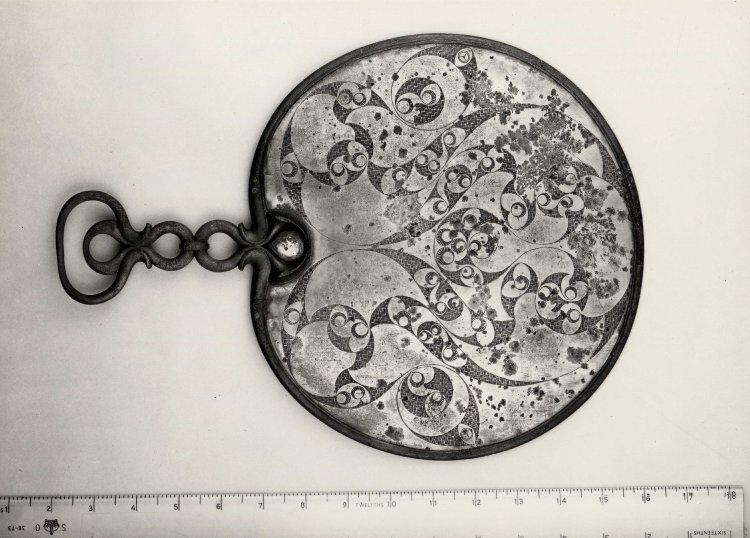
The symbol can best be described as a shape similar to a curved tear or kidney. The symbol was called Boteh (the Persian word for shrub or cluster of leaves) which is visually a combination of a spray of floral elements and a cypress. Centuries later the form was called blind almond (Buta Almond). The form of Buta is the national symbol of Azerbaijan to this day, which symbolizes fire and is most commonly seen in their intricate fabric rugs and shiny rugs. The shape of buta in Azerbaijan is related to the Zoroastrian religion dating back to the first millennium BC. The form of cashmere could also be an adaptation of the yin-yang symbol used in ancient Chinese medicine and philosophy.
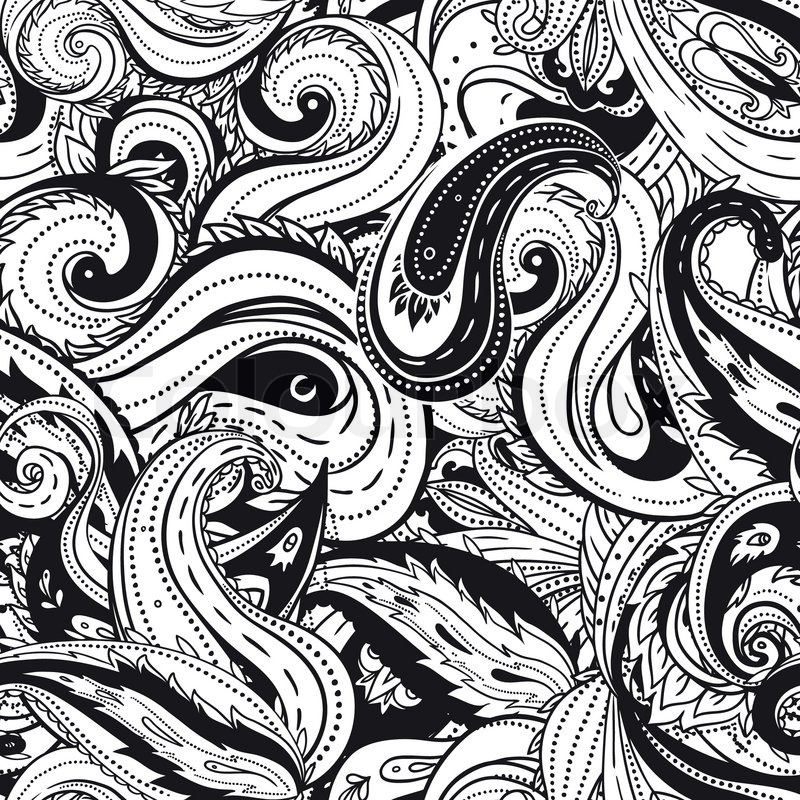
Many different cultures have used the cashmere symbol and consider it to represent many objects, including a cashew fruit (cashew nut in America), a mango or a date palm that sprouts, an Indian fertility symbol. The shape of the symbol varies dramatically in different countries, from an Indian pine cone to a Russian cucumber.
Paisleys may also go back to Celtic tradition. Before the influence of the Roman Empire prevailed in Britain, Celtic patterns were used in many highly decorated metal objects. The Desborough mirror, discovered in an archaeological excavation in Northamptonshire in 1908, was made in the Iron Age period in Britain around 50 BC to 50 AD. The complex engraved bronze mirror symbols, quite similar to cashmere shapes, can also be seen in their online collection listing.
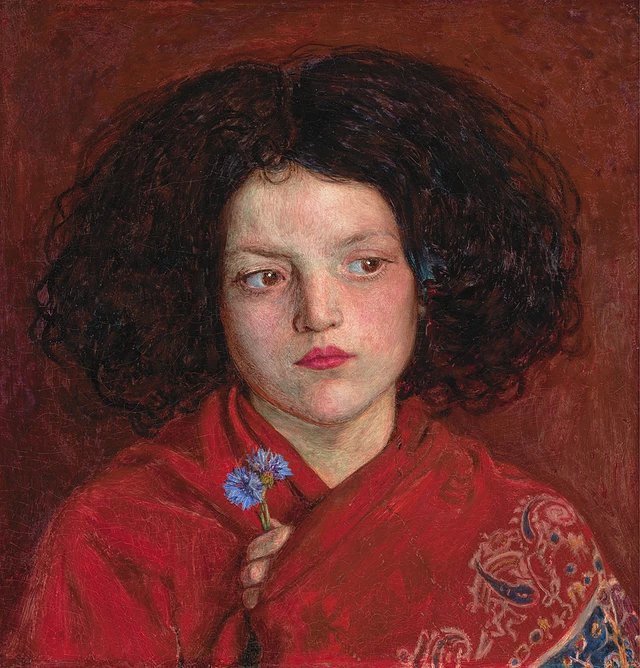
The cashmere pattern evolved mainly in the Kingdom of Kashmir. During the reign of Emperor Mughal Akbar (1556-1605), the production of shawl weaving increased dramatically. They are weavers who absorb the influences that come across the borders of nearby China, the Middle East and India. Woven cashmere shawls were mainly used by men for ceremonies. These early Shawls did not show the form of cashmere as we know it today, but a curvilinear flower with leaves and a stem, whose roots have striking similarities to Chinese calligraphy. The way the symbols of different cultures appear in the development of the cashmere pattern shows how weavers translated the artistic influences of ceramics, documents, and imported fabrics into their own designs.
The British East India Company imported Cashmere Shawls (adapted from the Persian word shal) from Kashmir and Persia into Europe in large quantities from around 1800. The designs were specifically designed to suit the particular tastes of each region. In Europe Shawls were worn mainly by women and not by men. The designs could depict exotic scenes of people on elephants passing by palm trees. For Middle Eastern customers, the curved geometric form of cashmere, as we know it today, was widely used. This was partly due to the Islamic preference not to represent recognizable natural objects.
European customers gradually preferred more complicated patterns in their Shawls. Therefore, in Kashmir, in order to speed up the manufacturing process, the "patchwork shawl" was invented. Woven fabric pieces from various looms were joined together to make a shawl.
The French Connection:
Joseph Marie Jacquard introduced the punch card system to the Lyon looms in 1804, resulting in the first programmable loom. This and other technological advances during C19 slowly reduced the high levels of child labour in the textile industries because the machinery became larger and more complicated, making it unsuitable for use by children. Before the jacquard loom, a child sat on top of each loom to raise and lower the loops. His invention made weaving 25 times faster with obviously dramatic increases in paisley shawl production.
In 1805, Napoleon and Empress Josephine, his first wife, visited Lyon and saw Jacquard's new loom and granted the patent, resulting in Jacquard receiving a royalty for each loom purchased.
Josephine, Napoleon I's first wife, supposedly owned hundreds of cashmere Shawls. These Indian and Pakistani Shawls were brought from Napoleon's campaigns in countries such as Egypt in the early 19th century. There are many portraits of Josephine wearing Shawls that were haute couture fashion and luxury. Creamy raw color is the natural color of goat wool.
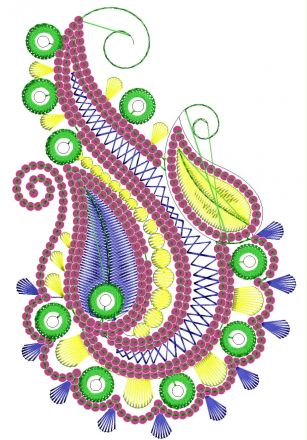
British production of Shawls:
British production of Shawls fabrics began in 1790 in Norwich, England, but to a greater extent in 1805 in the small town of Paisley, Scotland. Approximately equal quantities of imported Kashmir and domestically produced British Wales were purchased in Britain in mid-19th century. The former retained their popularity despite their much higher prices. The main reason is that cashmere is actually goat hair and these fine hairs are soft and provide excellent insulation. Therefore, cashmere was preferred to sheep wool, which was considered much less luxurious. The upper cashmere looms also produced completely reversible fabrics with many more colours. Initially British Shawls were only two colors, usually indigo and crazier. At its peak, between 1850 and 1860, the city of Paisley employed 6,000 weavers.
The name "Paisley":
Due to the large scale production of Shawls in Paisley, Scotland, the pattern was given the name "paisley". The name 'paisley' is not an international name for the patron, it is called "Palme" in France, "Bota" in Holland, "Bootar" in India and "Peizuli" in Japan.
The Scottish city was called Paisley as early as the 7th century. The first church was built on the site of the abbey in the 7th century. An ancient Celtic language was spoken in Britain at this time. Paisley' derives from the word Passeleg which means 'basilica' indicating a larger church. The church received abbey status in 1245. Parts of the present abbey date back to 1163. William Wallace, the Scottish knight and national hero of Scottish independence, was educated at the abbey. The expansion of the textile industry in the city dates back to the 17th century and is evident with street names that include the words thread, silk, shuttle, and cotton. Paisley is part of Renfrewshire, 1 of 32 Scottish councils; it uses the cashmere symbol as its official logo.
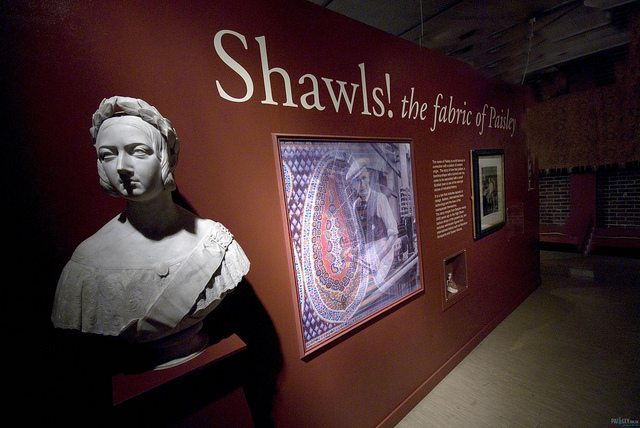
Popularity:
In Britain in the 19th century, the cashmere shawl was the essential accessory of its time, a status symbol worn on important occasions and recorded in numerous portrait paintings. Until photography became more available at the end of the 19th century, paintings recorded fashion trends. These paintings are now a valuable resource for the mapping stages in the development of cashmere patterns and variations in Shawl shapes and sizes. Ford Maddox Brown's 1860 painting shows that even a poor girl on the street selling flowers wears the fashion of the day, possibly a gift from a compassionate passer-by on a cold day. The painting by William Holman Hunt The Awakening Conscience (1853 - The Tate Britain, London) shows the woman wearing a red cashmere shawl in the middle and tied at the front, probably brought back by the man from a trip abroad.
Paisley's designs, intricate and dynamic forms that intertwine in exciting color combinations attracted a wide market. In Britain, mixed yarns of wool and silk were used, as Tibetan goat hair was not readily available. One failed attempt was to breed cashmere goats in Essex, England, in 1818. A small herd bred from two goats imported from Kazakhstan only produced very small quantities of the sotovelo, as the British climate was not cold enough. The breeding was then abandoned.
Design copyright:
Paisley's designs in Britain were one of the first examples of copyright protection in creative fields. Copyright in paisley designs dates back to the 1840s.
The paisley pattern designs used for Shawls continued to be used as examples of technical visual perfection. Detailed colour drawings drawn by hand on paper from the 1840s and 1850s were used as a visual aid to assist the teaching of design students in a variety of courses at the Glasgow School of Art from 1920 to the late 1940s.
Paisley's patterns were still used in the first half of the 20th century, but not as a dominant trend. A 1918 painting by artist Vanessa Bell at the Duncan Grant National Portrait Gallery (1885 - 1978) shows her wearing a red paisley dress. Noel Coward was often photographed in a paisley jacket or robe, very similar to that of the elegant detective Sherlock Holmes. Dean Martin and Frank Sinatra were also famous for wearing silk jackets with bold cashmere prints when they performed in Las Vegas or attended sumptuous parties. Frank Sinatra wore cashmere ties, including bow ties, often in the 1930s and 1940s. Images of cashmere Shawls continued to be used in popular culture.
The Great Return:
It wasn't until the late 1960s that paisleys returned to their former glory in the world of fashion. The new attraction to exotic musical and artistic influences catapulted them back to the boutiques, magazines and adorned the fashionable pop icons of the day, most notably The Beatles, The Rolling Stones, The Jimi Hendrix Experience, The Kinks, The Who and The Small Faces. Carnaby Street was the place to buy the latest in paisley fashion. John Stephen, a talented gay man from Glasgow, known as The King of Carnaby Street, was the leading male fashion designer/dealer in London in the 1960s. He was one of the leading designers contributing to The Peacock Revolution, an extravagant and vivid male fashion trend that allowed men to wear bold designs, including striking cashmere prints. It dressed the top rock stars of the moment in its 15 different boutiques on Carnaby Street with store names like Domino Male and Male West One. The Beatles began regularly visiting India in 1968 and embracing its philosophy, music and, of course, paisley fabrics. Cashmere design was commonly associated with rebellion; it was a declaration of non-conformity, a welcome alternative to sober fashion trends precedent. It was the perfect footprint for the hedonistic androgynous counterculture of the hippies. The hippie look is strongly tied to the psychedelic "Summer of Love" when 100,000 people gathered in Haight-Ashbury, a district of San Francisco, California, to share their common beliefs such as rejecting consumer values and fostering pacifism. Patrons of Paisley and other fabrics from around the world helped foster a multicultural spirit and, to the user, were visual statements of this principle.
Since the 1960s, cashmere has bounced off catwalks and main streets every few years. At the other end of the spectrum it became a sign of affiliation in gang culture. The bandana, named after the Hindi term "to tie," was originally an improvised dust mask for cowboys and a way to disguise their faces until it was adopted by Los Angeles bands in the late 1960s and then used by rock stars and their fans ever since.
After his untimely death on April 21, 2016, Alona Elkayam in The Huffington Post in her article entitled Paisley: A Pattern Made For A Prince, said in a tribute: "Prince, like cashmere, your music and your name will transcend generations and cultures. Thank you"
Florence Welch, singer of the band Florence and the Machine said in 2011: "I have to get a pair of shirts made with cashmere design, I love cashmere. Stella McCartney and Kenzo must have heard her plea. Florence became a paisley icon in 2012 wearing magnificent paisley dresses and costumes by these two top designers. His collection for Liberty Art Fabrics called 'Grace' was a reinterpretation of vintage paisleys from the Liberty-print archives.
2010 and The Future:
The universal popularity of the cashmere print means that new designs receive top-notch positioning in magazines, websites and shop windows. A garish design that received worldwide media coverage appeared at the 2010 Winter Olympics. The Azerbaijani team wore modern, colourful paisley trousers, which gave the small team (only 2 competitors) a large exhibition at the opening ceremony.
In 2009, the respected clothing brand Pretty Green was launched with Liam Gallagher at the front as founder and designer. It was named 'Men's Clothing Brand of the Year' at the 2010 Drapers Fashion Awards. Exclusive paisley prints are constantly present in collections such as shirts, polo shirts or shoes with the characteristic paisley lining.
The Italian fashion house Etro (Milan) continues to produce, without a doubt, the most beautiful paisley fashion prints in the world each season. Girolamo Etro created the Etro brand in 1968 in Milan. He was a famous art collector, from ancient Roman sculptures to 20th century painters such as Giorgio de Chirico. He accumulated a collection of 150 cashmere Shawls dating from 1810 to 1880. In the early 1980s he introduced cashmere printing to the Etro collections. They were so successful that the label is now the brand most closely associated with the cashmere pattern.
Closer to home, Liberty of London continually reinvents the cashmere print as can be seen on the beautiful silk pic16 scarf. In recent years, the catwalk collections of many leading designers such as Balenciaga, Jill Sander, Jonathan Saunders and Stella McCartney have introduced exciting new cashmere takes. Massimo Dutti's spring/summer 2014 collection featured a variety of paisleys in blue tones, including scarf print garments. Actress Kate Hudson appeared on the front page of InStyle magazine in July 2014 in an elegant red and pale blue paisley bikini. Lauren Laverne's article in The Observer in May 2014 entitled "Eye-popping Paisley" highlighted the importance of cashmere printing "essential for achieving the boho look or festival chic, cashmere would be the dominant statement print during summer and fall, but especially looking forward to the fall and winter 2014 collections.
In 2014 Paisley Power was launched, the brand created by British textile designer Patrick Moriarty. Patrick creates modern interpretations of the cashmere pattern. His fabric print designs are regularly used to make top-selling fashion garments and home textiles manufactured by major international retailers. His most popular and recognized design is his cashmere print.
In February 2015, Rebecca Gonzales' double-page article in The Independent newspaper highlights the importance of Persian landscapes in the renaissance of the late 1970s. Titled "Get Your Groove On," the article says the 1970s are back and provide perennial inspiration for summer collections. The return of the paisley poncho for men and women took place in 2015. Paisley eveningwear was a bestseller with the Mirror newspaper announcing that "M&S (Marks and Spencer) was quickly sold in pure cotton pajamas with a cashmere print.
In 2016 several major fashion houses have included cashmere prints in their spring-summer collections. These include Gucci, Isabel Marant and Saint Laurent.
In 2016, British fashion designer Alexa Chung collaborated with Marks and Spencer to produce a collection. She revived several vintage pieces from the M&S archive, including a 1950s "Eliza" paisley minidress, which received favorable coverage in the Daily Telegraph article on February 19, 2016.
In 2017 Pringle of Scotland, the luxury knitwear brand, in collaboration with the Paisley Museum, will use paisley archival patterns in its autumn/winter 2017 collection. Previously, the brand had used cashmere prints in the 1960s, so it is a welcome return for cashmere to feature in Pringle's knitwear range. You can read more about this collaboration in the article entitled Paisley Pattern 'on trend' with Pringle on the Paisley 2021 website.
To accompany our love of paisley fashion, we can surround ourselves with paisley fabrics, wallpapers, screensavers and iPhone cases. They all show that this organic symbol, whether a flower, a tree or a sprouted seed, is so adaptable that it will continue to grow in any direction a designer desires for decades to come. Since I'm talking about growing, there's even a plant called "Lakeside Paisley Print," bred by Mary Chastain in the 1990s. She is a horticulturist who lives near the shore of Lake Chickamauga in eastern Tennessee. She has leaves that resemble cashmere shapes with cream-colored feather marks in the center of wavy cashmere shaped leaves.
Preservation for future generations:
In 2015 a project was initiated at the Paisley Museum, Scotland, to digitally record its entire collection of 1200 cashmere Shawls, most of which are approximately 200 years old. It is one of the largest collections of paisley Shawls in the world and is officially listed as a Recognised Collection of National Importance to Scotland. Each shawl will be carefully photographed and scanned. The museum is also making digital copies of all its pattern books, so there will be a detailed reference installation of thousands of historical cashmere patterns. This is one of many projects in the museum where a high priority is the conservation of many aspects of its fascinating landscape heritage. The project was completed in June 2016.
In September 2016, Paisley Museum textile curator Dan Coughlan was featured in the Independent newspaper as part of the city's PaisleyMake Festival of Creativity and Design. This 4-day event was an opportunity for designers and craftsmen to celebrate and discover Paisley's textile heritage. Speakers included representatives from local textile and fashion companies. Dan Coughlan gave a talk on the museum's historic collection of cashmere prints.
A new digital art project will be on display at the Paisley Museum from November 2, 2016 to January 15, 2017. The project will create 7.3 billion cashmere patterns - that's definitely enough to get me out of business! This huge number of patterns reflects the huge amount of cashmere patterns created in Paisley village in the past. Obviously, the city weavers of the 19th and 20th centuries did not create billions of designs, but they did create more than any other town or city in the world in a period of 100 years. It is true that some of the designs woven in the city of Paisley were copies of designs created by the native weavers of Kashmir, but many designs were created in Scotland by Scottish designers. The software used to create the new digital cashmere patterns allows the images to be displayed on a high-definition screen mounted on a replica of a 19th century loom. The project is described as "transforming Paisley's world-famous pattern for the digital age".
The future is bright and the cashmere of the future!
Congratulations to Paisley, Scotland, for reaching the final list of finalists in the candidacy for UK City of Culture 2021. The BBC described Paisley as follows: "This city of Renfrewshire, with a population of 76,000, is perhaps the most famous for Paisley's engraving, intricate and colourful designs inspired by 18th century cashmere patterns and popularised in the psychedelic 1960s. Unfortunately, Paisley was not chosen as the winning city; Coventry was the winner.
Japanese fashion designer Yoshio Kubo, graduated from the University of Philadelphia in 2000, has used bandanas and cashmere prints in an exciting way in his Fall/Winter 2017-18 men's collection.
In May 2018, pop singer Miley Cyrus collaborated with the iconic footwear brand Converse to launch a new range of cashmere printed garments and slippers. The fashion and footwear collection is described as vegan as she is a passionate animal rights activist, meaning that the collection was made without cruelty to animals.
On 23 May 2018 Charlie Gowans-Eglinton, chief fashion editor of The Telegraph, UK Newspaper, published an article entitled "Fed up with florals? The countries of this season have a great power of impression". It confirms the importance of paisley prints in fashion in 2018. Included in the article is a concise history of the cashmere pattern that emphasizes its cultural connections through the centuries.
Meet Our Paisley Creations in Spain
Adaptation and Translation of Sources such as www.paisleypower.com

